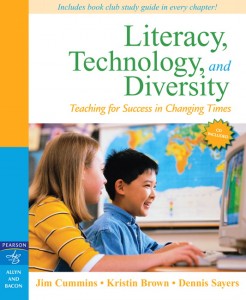Jim Cummins, Kristen Brown and Dennis Sayers discuss several productive uses of technology in multilingual classrooms.

Nearly two decades later, teachers and students in another California school, this time in Fresno, are once again using computers to build bilingual dictionaries. And in a way, this community is also engaged in a project of language rescue and cultural identity. Ann Leavenworth Center for Accelerated Learning, an elementary school, began its two-way bilingual immersion program, Estrellas (Stars) in 1997. In Estrellas, about half the children in each grade are from families whose dominant language was Spanish in kindergarten, and the other half come from homes where English is spoken. Instruction is provided by team teachers who, while bilingual themselves, model one and only one of the two target languages. …
After consulting with their teachers to develop a list of important terminology on their current unit of study that will be included in Nuestro Diccionario, partners begin the key process of selecting a word and developing its definition in Verbs & Nouns. They consult a number of reference works on their Bilingual Reference Shelf, which contains several comprehensive monolingual Spanish school dictionaries, a number of bilingual picture dictionaries, and a classroom encyclopedia in Spanish. The ground rules are simple: They may consult any reference work, but they may not have it open while they are jointly writing their definition. “That would be copying,” explain the lexicographers to visitors.
In their discussions of each definition’s nuances, it is plain that Estrellas students are linking academic oral language with sophisticated vocabulary development (see Cognition and. Assessment sidebars). Jeffrey Thornton, an African American student, was working with Jessica Valdez on the definition of canal for their geography unit. He saw that many English definitions used the term man-made, but Jessica informed him that “no se dice asi en Espafiol” (that’s not how you say it in Spanish), that the Spanish cognate “artificial” sounded better. Both these children were very familiar with canals in Fresno, where irrigation canals carry water many miles from the melted snow of the Sierra Nevada mountains to the orchards and farms outside the city. But as they developed their definition, Jeffrey felt that they shouldn’t just talk about irrigation canals; what about the canals in Panama and east of the Mississippi that they had read about in previous social studies and history units? Their final definition: “Un canal es un no artificial que conduce agua o barcos por una ruta especiflca” (A canal is an artificial river that conveys water or boats over a specific route). … Estrellas students showed their sense of “ownership” and pride in their definitions by signing each one and reading their “signatures” as they made their recording, much as the pioneering lexicographers who wrote the Oxford English Dictionary a century before would add their initials to their work. …
Clearly, their insiders’ understanding of dictionaries departs from the common conception of a comprehensive reference tool written by experts, serving as ultimate arbiter of acceptable standard usage. Yet these young lexicographers have much in common with dictionary pioneers of other eras. The first dictionaries, indeed, were bilingual dictionaries that arose soon after the advent of printed books in order to meet the commercial and cultural communication needs of multilingual societies living in close contact. … In this sense, Nuestro Diccionario is similar to the earliest dictionaries, selecting the key words that need definition to advance students’ learning.
Cummins, Jim, Kristen Brown & Dennis Sayers. 2006. Literacy, Technology, and Diversity: Teaching for Success in Changing Times. Boston: Allyn and Bacon. pp. 185-193. || Amazon || WorldCat
